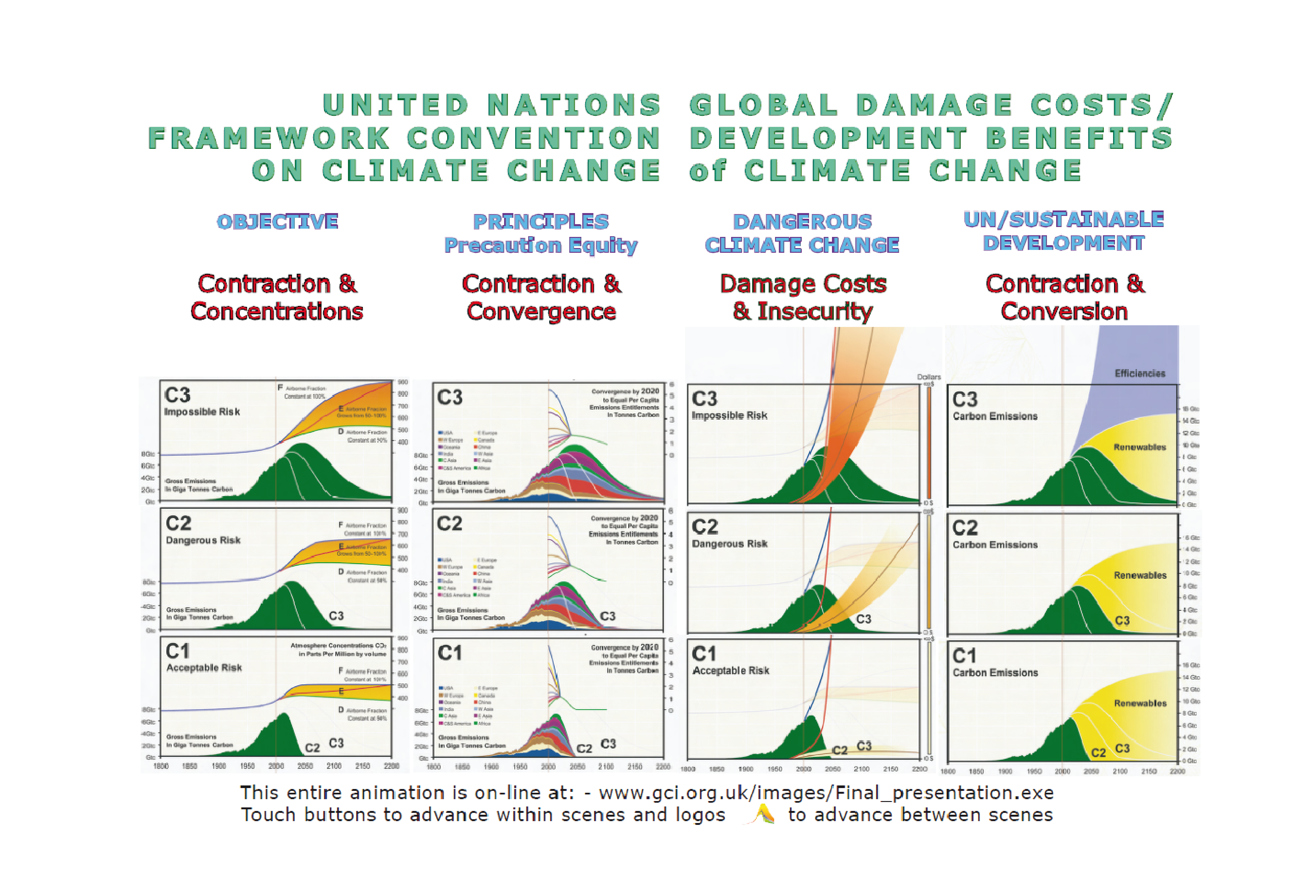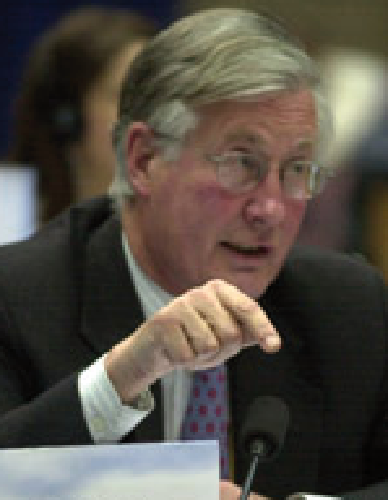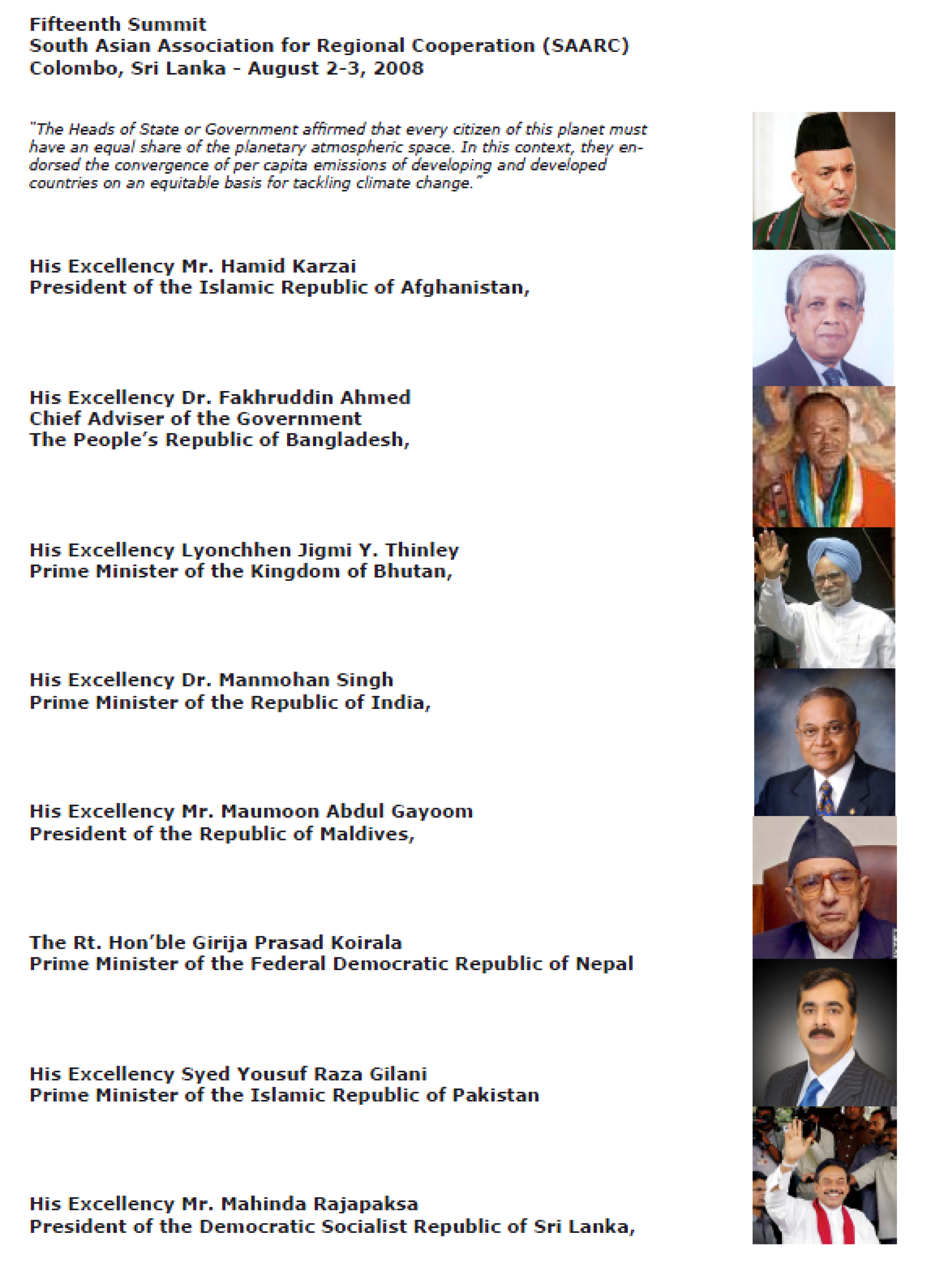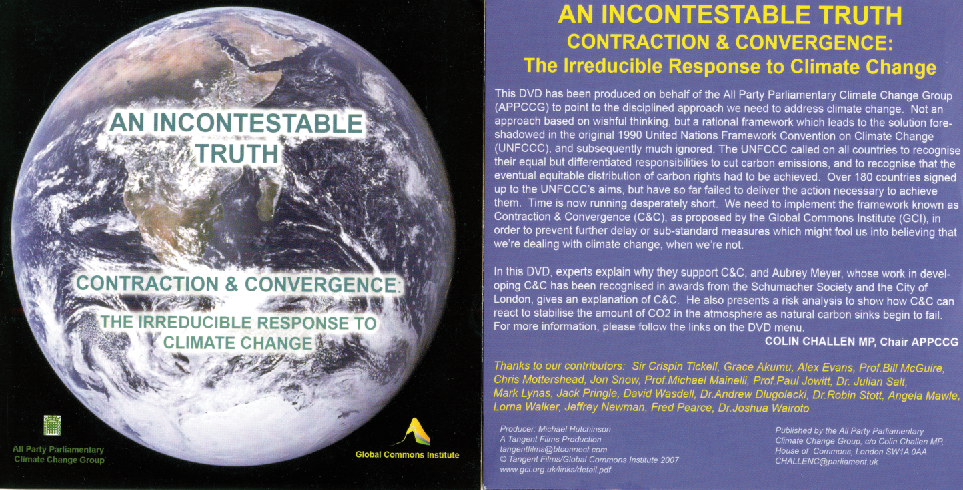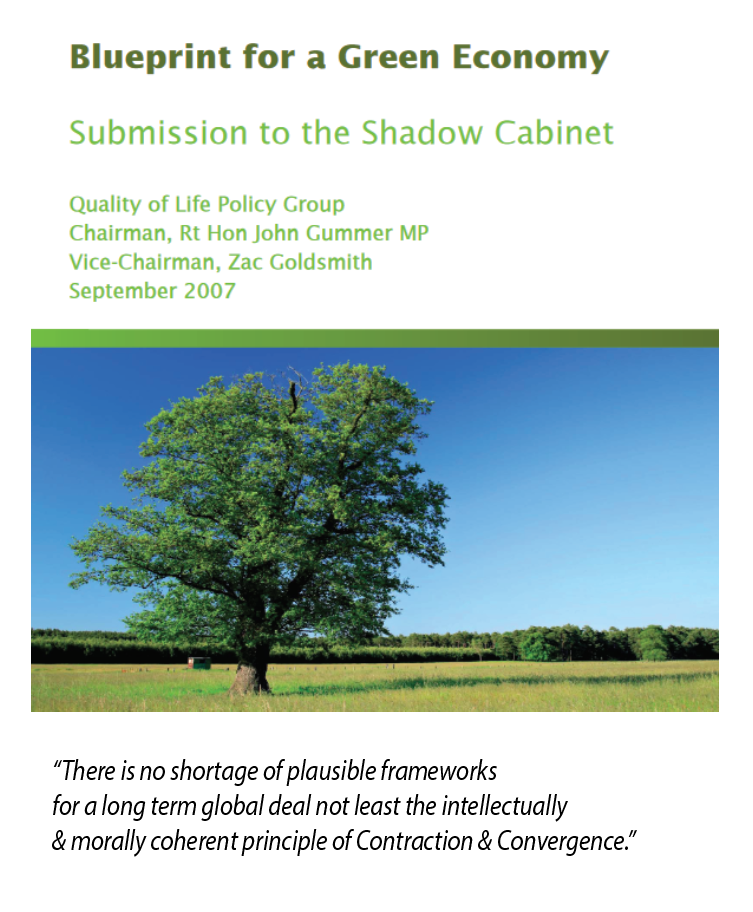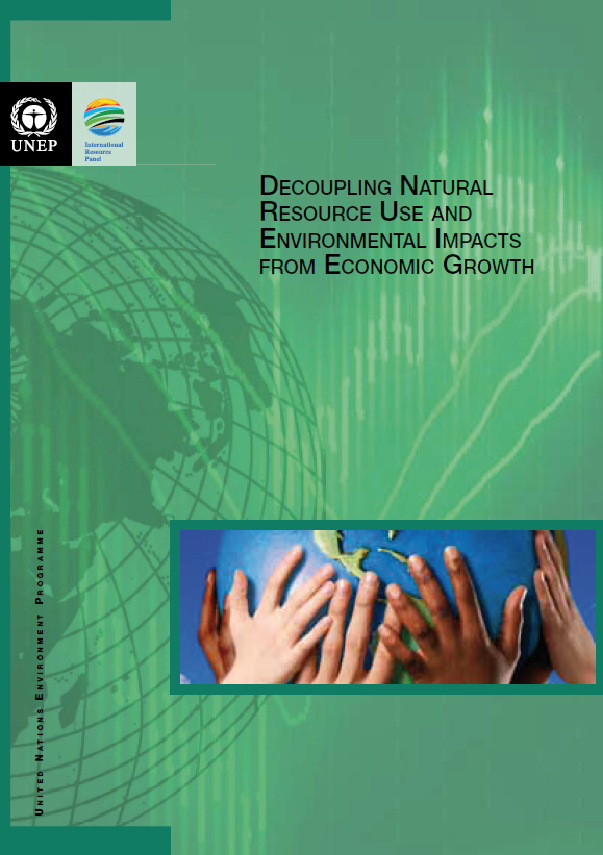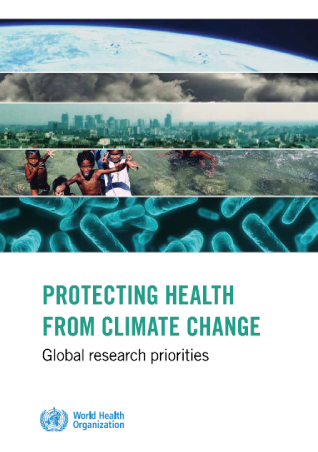C&C Proposal to UNFCCC (2012)
Dear Friend and Colleague
Please will you consider supporting GCI's C&C Proposal to the UNFCCC.
The UNFCCC are now debating the way ahead beyond 2012 and invited submissions from observer organisations.C&C is already well-supported but details of the current proposal from GCI are below and also in extended form at this link
It is a very straightforward re-statement of how to use C&C as the collective basis of the negotiating framework needed for UNFCCC-compliance. The many people who co-signed Colin Challen's pro-C&C letter to Chris Huhne when he became the Minister at DECC in 2010 have been approached. That letter with signatories to it is at the foot of this page and here and there were over 500 signatories all told on that.
Your support would be welcome, useful and influential if your name were added in support of the present proposal to the UNFCCC.
So if you feel you are able to support the present proposal, please will you send me [minima] a one-line e-mail saying just that and I will add your name and affiliation to the list that is being collected and conveyed to the UNFCCC Executive.
With best wishes
Aubrey Meyer
GCI
After 23 years there is a diverse and growing volume of support for C&C: -
http://www.gci.org.uk/news.html
http://www.gci.org.uk/endorsements.html
GCI Submission to UNFCCC 28 02 2012
Negotiating UNFCCC-compliance globally, *Accelerating the rate of Convergence relative to the rate of Contraction* provides *the Main International Equity Lever.*
Negotiating UNFCCC-compliance globally, *Accelerating the rate of Convergence relative to the rate of Contraction* provides *the Main International Equity Lever.*
‘C&C has the virtue of simplicity. Equal per capita emissions is a natural focal point. Contestable computations based on economic variables do not need to enter the allocation formula.
Review of Climate Change Economics to the Australian Government by Ross Garnaut - 2008
“Since the principle of ‘contraction and convergence’ was first proposed by the Global Commons Institute in 2000, it has been widely embraced by some industrialised countries. Under contraction and convergence, each country will start out with emission entitlements equal to its current real emissions levels, and then, over time, converge to equal its per capita entitlements, while the overall global budget contracts to accommodate the emissions reduction objective. The convergence principle should be applied immediately rather than later as the ‘converged point’ in the future. ‘Real emissions’ is a different concept to ‘emissions entitlements’. A country’s high/low per capita real emissions cannot justify its high/low emission entitlements. In the process of convergence, the rights and interests of country B are really infringed by country A. In the National Emissions Account-based solution, the concept of convergence can still be incorporated, but it now merely means ‘convergence of real emissions’ rather than ‘convergence of emission entitlements’. Each country’s gaps between its emission entitlements and real emissions need to be balanced by the traded emissions quotas.”
Development Research Council to the Chinese Government - 2009
“We believe that it is difficult to imagine a global deal which allows the developed countries to have emissions per capita which are significantly above a sustainable global average.”
UK Government’s ‘Committee to the Climate Change Act'
This is an extended version that includes animations and a movie.Contents
Page 1 Convergence by 2010 or 2020 or 2030 or 2040 or 2045 or by 2050
Page 2 Contents & UNFCCC decisions [COP-17] for 'increased ambition'
Page 3 C&C memo to UNFCCC in response to these decisions
Page 4 Charts with distributive effect of different convergence rates
Page 5 Notes to memo and links to references Annexes & Movie below, are in the full document at: -
Page 6 - 7 Original C&C Briefing
Page 8 Graphic overview of UNFCCC-compliance
Page 9 - 11 Article in UNEP's 'Climate Action' on graphic overview
Page 11 Animations of different rates of C&C as laid out in IPCC C&C Movie from the C&C Foundation
Page 12 Movie shows a strategic approach to negotiating international agreement for achieving UNFCCC-compliance.Also here
[1] The ‘convergence-rate’ is the ‘main equity lever’: the faster the rate of convergence, the greater the extent to which ‘historic responsibilities’ are compensated for.
[2] Regional grouping between countries - for example between India and China - the greater the bargaining power for achieving a result with ‘convergence accelerated relative to contraction’.
1. Inclusive global rationale for UNFCCC-compliance needed now.
The increased ambition called for at COP-17 by the UNFCCC Parties requires we now quantify and demonstrate an inclusive global rationale to achieve UNFCCC-compliance. This was recognized by India, China, the USA and the Africa Group at COP-3 in Kyoto in 1997. [See note 0].
2. Contraction & Convergence [C&C] 'Inevitably required' for UNFCCC-compliance.
The objective of the UNFCCC is safe and stable Greenhouse Gas concentration in the global atmosphere. As the cost of failure is incalculable, in a measured and time-dependent way, we must ‘do-enough, soon-enough’ to quantify, arrange and then achieve compliance’ with that objective. C&C is a rational calculating model, but also a ‘negotiating mechanism’ to do just that. However, before it is a ‘flow-process’, C&C is a ‘stock-concept’. It is non-random and logical. As such it has been called ‘An Incontestable Truth’ by an All-Party Group of UK MPs [See note 8]. The UNFCCC Executive took the position at COP-9 in 2004 saying C&C is ‘inevitably required’ for UNFCCC-compliance [See note 1].
3. C&C integrates two primary issues needed for this; it now has much support.
C&C was first proposed to COP-2 UNFCCC in 1996 by GCI. The purpose is to help UNFCCC negotiators integrate, quantify and reconcile the two primary issues they are still faced with, to achieve 'climate-justice without vengeance'. It is offered again now, along with some of the support that it has generated since then. The depth and diversity of this support is now very considerable [See note 8].
[1] Contraction: The 1st issue is to quantify the full-term global greenhouse emissions contraction-event that is inevitably required for UNFCCC-compliance. For reasons of ‘urgency’, the question is what ‘path-integral [full-term, rate, carbon-weight, date] of the global emissions contraction-event do we jointly need to estimate and agree is needed for UNFCCC-compliance? Another way of asking this, is how much carbon consumption is still ‘safe globally’, if dangerous rates of climate change are to be avoided? We must be guided by the need to solve this problem faster than we are creating it. Empirically, estimating the global emissions contraction-event is primarily a science-based judgement. So here the UNFCCC is largely dependent on the IPCC’s estimates of ‘climate-sensitivity’ and global monitoring of source, sinks and stocks of Greenhouse Gases [GHG] that are active in the Earth’s climate system. As all we can control are GHG from human sources, C&C pays particular attention to those.
[2] Convergence: The 2nd issue is to resolve the question arising as to how we integrate and internationally share that contraction-event in a rational and transparent manner. An international convergence of shares under a global contraction-event is inevitable. So the key question here is how will this sharing arrangement of permissible future ‘emissions-rights’ come about? Will it result from [a] random guesswork [b] a better-intentioned network [c] a continuing aspirational patchwork [d] or now finally adopting the 'constitution of C&C’s rational and inclusive framework? Politically, this is a primarily an equal-rights-based judgement and therefore a constitutional issue. C&C assumes that, as any defence of unequal rights will lack support internationally, equal rights is the only logically defensible position, politically.
4. International Shares must sum to no more than total of Contraction-Event
However, the shares or emissions-rights arising are rational fractions of the contraction-event needed for UNFCCC-compliance. Shares must sum to no more than the total weight of emission-rights available under that contraction-event. This is a logical - and not an ideological - requirement. So, possibly with a population base-year being chosen for the accounts, all shares for all Countries [or Regions of Countries] result from an accounting procedure that calculates how shares result from an international convergence on the global per capita average of consumption arising under the contraction-event chosen for UNFCCC-compliance. As a first order argument, this is the incontestable truth of C&C. There are no contestable ideological assumptions or economic computations in the model whatsoever.
5. Logic precedes contestable economic computations & ideological assumptions
Attempting to calculate global UNFCCC-compliance any other way, is to remain stuck in the contestable ideological assumptions and economic computations that have bedevilled the negotiations for the last twenty years. This ideological dead-lock has made consensus impossible and these computations and assumptions have made UNFCCC-compliance, unquantifiable, un-negotiable and unachievable.
6. C&C, Historic Responsibilities & the 'Main Equity Lever'.
Inequity attends the 'historic responsibility' for causing climate change with emission accumulated in the atmosphere since 1800. To redress this & offset the future opportunity cost to fossil-fuel-based development in developing countries, the 'main equity-lever' is negotiating a rate of convergence that is significantly accelerated relative to the rate of contraction [Prof Ross Garnaut].
7. Accelerated Convergence - 'Emissions Entitlements' are not 'Emissions per se'.
As the Chinese Government has stressed, since global carbon-trading requires that the 'emissions entitlements' are tradable these are necessarily different from emissions per se. The faster the convergence rate is relative to the contraction-rate, the more the 'equity-share' is transferred from the accounts of those consuming carbon above the global per capita average to the accounts of those consuming carbon below that average. So under-consumers have a mechanism with which to leverage their position 'at the expense of over-consumers', while - crucially - all remain subject to the contraction rate, weight & date agreed for UNFCCC-compliance. The question is what rate of convergence [fast/slow] relative to the contraction rate agreed, can the international negotiations bear?
8. Turn Kyoto's 'market-based framework' into C&C's 'framework-based-market'.
Integrated this way, C&C turns Kyotos' aspirational 'Market-Based-Framework' into a rational 'Framework-Based-Market'. Agreeing the rates of C&C is the primary task and this is primarily the task for UNFCCC negotiators. This approach does not preclude additional side-agreements of any kind.
9. Making Regional Groupings makes negotiating headline rates of C&C easier.
GCI does not presume to prescribe what the rates of C&C must be. GCI’s role has simply been to demonstrate [quantify & visualize] linking the range of contraction-rates examined in the global ‘science-debate’ to the convergence-rates involved in the international ‘policy-debate’ [see note 3]. However, GCI feels it would certainly facilitate policy negotiations if India and China [& others] grouped together as regions in the way for example the EU acts as a region, as this would remove intra-regional negotiations from the COPs to the UNFCCC and negotiations would be more ‘strategic’.
10. C&C & a negotiating example, based on what happened at COP-15.
At COP-15 in December 2009, the UK was part of a group of Governments that prescribed the rates of C&C that are in the UK Climate Act [see 4]. They prescribed that convergence to globally equal per capita shares should complete by the year 2050, but by when 80% of the available carbon budget was used up.
11. Right principle prescribing wrong rates at COP-15: negotiate rates at COP-18.
This was the right principle but prescribing the rates was a mistake. Moreover, it was prescribed at rates that were unacceptable to the majority [see note 5] & it was rejected by the non-annex One countries. Understanding this reason for that failure and correcting it is key to any future success. Already in July 2009 the Chinese Government wrote that those rates of C&C were acceptable for per capita emissions per se, but for equal per capita emissions-rights or ‘emissions-entitlements’, they were looking for a ‘global climate deal’ with immediate convergence, rather than the gradual convergence over a 40 year period to 2050, by when 80% by weight of the global emissions-budget would have been used up [see note 6]. Negotiators now need to close the ‘convergence-gap’ between now and 2050. It is crucial to note that technically with ‘emissions-trading’ these two positions are quite compatible. Politically, the ‘gap’ between them can better be resolved through more clearly quantified negotiations, than with more opaque ‘prescriptions’ by sets of Governments, complicated by ‘lobbying’ from sector interests loaded with contestable economic computations and ideological assumptions.
12. Negotiating Convergence Rate: 2010, 2020, 2030, 2040, [COP-15 prescribed 2050].
The intervening positions on the rate of convergence, with weight and value [$100/tonne] are: -
by Year
to LDCs in Billions Tonnes Carbon [Gt C]
The full submission goes on to analyse rising-risk and how to use C&C to orgnanize to face that.In this material there is an overview chart showing 3 scenarios:
C3 - Impossible Risk
C2 - Dangerous Risk
C1 - Acceptable RiskThe C1 scenario clearly shows a full-term C&C-event to achieve zero emissions globally by 2050.
This analysis is explained in the article in the submission, which is also published separately by Climate Action [UNEP] here
Because of the momentum now in the damage curve, it is clear that the C1 - 'Acceptable Risk' - scenario is the case argued for.
Climate Action 2007 C&C
"Technically, the C&C model is a coherent and mathematically-stable framework. It holds the science policy content together as a unity, science-based on the contraction side of the argument and rights-based or 'constitutional on the 'political' side of the argument. C&C is in effect a bill of rights, It simply plots a full-term event for achieving equal per capita emissions rights globall [Convergence] but governed by the overall emissions limit over time that stabilises the atmosphere concentration of GHG at a 'safe' value [Contraction]. The UNFCCC makes C&C generically true, but C&C specifically embraces a calculus built on this truth."
NOTES
[0] Transcript of the final session at COP-3 1997: -
[1] C&C 'Inevitably required': -
[2] High Level Statement, Asian Development Bank, Manila June 2009"The framework of contraction and convergence provides a flexible methodology
to address the problem of allocation of emission rights. The contraction of overall
world emissions pursued along with the convergence of countries average per
capita emissions, allows developing countries to partake of the carbon budget. The
per capita entitlements approach is an effective one in that it takes into account
historical responsibility and is based on the egalitarian distribution of the commons,
within which international justice positions of causal responsibility 'such as the 'polluter
pays principle', come in."Ursula Schaefer-Preuss - Vice President of ADB.
Haruhiko Kuroda - President and Chair ADB Board.
Ban Ki-moon - Secretary General of the United Nations.
Rajendra Pachauri - Director of TERI, Chair IPCC.
Yvo de Boer - Former Executive Secretary UNFCCC.
Gloria Macapagal Arroyo - President Philippines.
Zhou Dadi - Chief advisor national energy strategy, People's Republic of China.
Full Signatory List to this statement of over thirty eminent people: -[3] Rates of C&C: -
[4] C&C in UK Climate Act
[5] C&C - Right Principle & correcting Wrong Rates projected COP-15.
[6] Chinese Government accepted the C&C Principle July 2009 with 'their' rates: -"Since the principle of 'contraction and convergence' was first proposed by the Global
Commons Institute in 2000, it has been widely embraced by some industrialised
countries. Under contraction and convergence, each country will start out with emission
entitlements equal to its current real emissions levels, and then, over time, converge
to equal its per capita entitlements, while the overall global budget contracts to
accommodate the emissions reduction objective. The convergence principle should
be applied immediately rather than later as the 'converged point' in the future. 'Real
emissions' is a different concept to 'emissions entitlement'. A country's high/low per
capita real emissions cannot justify its high/low emission entitlements. In the process
of convergence, the rights and interests of country B are really infringed by country
A. In the NEA-based solution, the concept of convergence can still be incorporated,
but it now merely means 'convergence of real emissions' rather than 'convergence of
emission entitlements'. Each country's gaps between its emission entitlements and
real emissions need to be balanced by the traded emissions quotas."Greenhouse gas emissions reduction - a theoretical framework & global solution
Development Research Centre of the State Council People's Republic of China 2009
[7] Seeking a negotiation to 'correct' rates of C&C - see opposite and here: -
[8] Diverse and general endorsements of C&C after 20 years & News
[9] C&C Foundation
[10] C&C Foundation DocumentDear Chris
UNFCCC-compliant Global Climate Change Framework
We all face an increasingly urgent situation with the threat of runaway rates of climate change occurring and the persistent failure to come to terms internationally to deal with this. COP-15 was another example of this and the odds for COP-16 appear no better as things stand.
So we write to you with the request to convene a high-level public meeting to focus on this predicament and the international need to establish a UNFCCC-compliant Global Climate Change Framework to redress this threat as soon as possible.
Contraction and Convergence is a prime example of this. It is a rational formulation for reconciliation of 'Climate Justice without Vengeance'. With the growing support for this approach internationally, we specifically note the positions taken in the UK context by: -
- The UNFCCC Executive at COP-9 [2004] - achieving the objective of the UNFCCC "inevitably requires contraction and convergence".
- The Liberal Democrat party that, "an agreement must be based on reducing emissions overall, while equalising emissions between the developed and developing worlds "the principle of contraction and convergence."
- Yourself and what you called the "morally compelling logic" of C&C.
- The All Party Parliamentary Group on Climate Change in the previous parliament.
- The UK Climate Act, which Adair Turner effectively characterised as C&C in evidence to the EAC and DECC select committees last year saying that converging to equal per capita entitlements globally is the only option that is, "doable and fair" for organising and sharing the full-term emissions-contraction-event to bring us to UNFCCC-compliance and that "if, for reasons of urgency the rate of global contraction has to be accelerated, for reasons of equity the rate of international convergence has to be accelerated relative to that."Â
Several ideas derived from C&C have surfaced since Kyoto with ideas that can be perhaps in various ways incorporated into C&C. However, there is an overwhelming need for an over-arching UNFCCC-compliant Framework that enables the globally competing interests of the over-consuming and the under-consuming to be reconciled with each other and with the objective of the UNFCCC in a non-random manner.We feel that C&C is the veteran and indeed the apex example of this and urge you to consider our request. At Kyoto in December 1997 and shortly before they withdrew from these negotiations, the USA stated, "C&C contains elements for the next agreement that we may ultimately all seek to engage in."
The adversarial reasons for their withdrawal then were in play again at COP-15: - http://www.gci.org.uk/public/COP_15_C&C.swfC&C answers this in a unifying and constitutional way and the need for this answer becomes increasingly critical.
With best wishes
Yours sincerelyColin Challen
Former Chair UK All Party Parliamentary Group on Climate Change
Professor Sir Tom Blundell FRS, FMedSci,
Department of Biochemistry, University of Cambridge,
Former Chairman of the Royal Commission on Environmental Pollution
Professor Peter Guthrie OBE
Professor in Engineering for Sustainable Development in the UK
Fellow of St Edmund's College Cambridge
Professor Martin Rees
Trinity College Cambridge
Sir John Houghton
President, John Ray Initiative
Michael Hutchinson
CEO Tangent Films
The Rt Revd & Rt Hon Richard Chartres KCVO DD FSA
Bishop of London
Anthony J. McMichael, MBBS, PhD
Professor and NHMRC Australia Fellow National Centre for Epidemiology & Population Health
ANU College of Medicine, Biology and Environment
Australian National University
Honorary Professor of Climate Change and Human Health, University of Copenhagen
Ruth Reed
President Royal Institute of British Architects [RIBA]
Sunand Prasad
Former President of RIBA
Maneka Gandhi
Member of Parliament India
David Wiggins
Wykeham Professor of Logic, Emeritus, Oxford University
Lord David Puttnam
Film Producer
Jack Pringle
PPRIBA Hon AIA FRSA Dip Arch BA(hons)
Partner Pringle Brandon LLP; Director WIRED architects Ltd
Chair Article [25] (UK reg. charity 1112621 for Development and Disaster Relief)
Vice Chair Construction Industry Council (CIC)
Council Member International Union of Architects (UIA)
Past President Royal Institute of British Architects (RIBA)
Commandeur Des Arts et Lettres
Sir John Harman FRSA Hon FICE, FIWEM, FIWM, FSE, DCL
Professor Aubrey Manning, OBE,FRSE
Emeritus Professor of Natural History, University of Edinburgh
Tim Livesey
The Archbishop of Canterbury's Secretary for Public Affairs
Sir Crispin Tickell
Director Policy Foresight Programme Oxford University
Professor Sir Michael Marmot MBBS, MPH, PhD, FRCP, FFPHM,FMedSci
Director, UCL International Institute for Society and Health
MRC Research Professor of Epidemiology and Public Health, University College London
Chairman, Commission on Social Determinants of Health
Chairman, Department of Health Scientific Reference Group
Professor Sir Andy Haines
Director, London School of Hygiene & Tropical Medicine, London WC1E 7HT
[in a personal capacity]
Professor Brendan Mackey
The Fenner School of Environment & Society
The Australian National University
* Member, IUCN Council (Oceania Regional Councilor)
* Member, Earth Charter International Council
Professor David Orr Environmental Studies and Politics Oberlin College and James Marsh Professor at the University of Vermont.
Alistair Woodward
Head of the School of Population Health, University of Auckland
Dr Nigel Woodcock
Reader, Department of Earth Sciences, University of Cambridge
Roger Arthur Graef OBE
criminologist and film-maker
Professor Bill McGuire
Director, Aon Benfield UCL Hazard Research Centre
University College London
Lord Anthony Giddens
Professor Emeritus LSE
Susan Richards
non-executive director and founder of openDemocracy
John Carstensen
Chief Executive Officer Society for the Environment
Professor Mark Swilling
Sustainability Institute, School of Public Management and Planning
Stellenbosch University, South Africa
Lynne Jackson
Coastal & Environmental Consulting
Cape Town, South Africa
Dr David Pencheon
Director - NHS Sustainable Development Unit (SDU)
Professor Anthony Costello FMedSci,
Director UCL Institute for Global Health
Tom Spencer
Vice Chairman, Institute for Environmental Security
Dr Mayer Hillman
Senior Fellow Emeritus Politcy Studies Institute
Susan George
President of the board of the Transnational Institute
Alex Kirby
Former BBC News environment correspondent
Professor Tim Jackson
Sustainable Development Surrey University
Director of the Research group on Lifestyles, Values and Environment
Professor William E. Rees, PhD, FRSC
UBC School of Community and Regional Planning, Vancouver, BC, CANADA
Jeremy Leggett
Chairman Solar Century
Andrew Dlugolecki
UK Climate Change Committee Member, Sub Committee on Adaptation
The Hon. Tom Roper
Board Member, Climate Institute, Washington DC
Adam Poole
The EDGE UK
Professor Lord Smith of Clifton
Peter Head,
Chairman of Global Planning Arup.
Linda Rosenstock MD, MPH
Dean, UCLA School of Public Health
Former Director, U.S. National Institute for Occupational Safety and Health
Professor Alan Maryon-Davis
President, UK Faculty of Public Health
John Guillebaud
Emeritus Professor of Family Planning & Reproductive Health, UCL
Professor Hugh Montgomery
Director, UCL Institute for Human Health and Performance
Dr Robin Stott
Director of the Climate and Health Council
Emeritus Professor Brian Moss
University of Liverpool
Steven Earl Salmony
AWAREness Campaign on The Human Population [estab. 2001]
Robert Costanza
Gordon and Lulie Gund Professor of Ecological Economics
Director, Gund Institute for Ecological Economics
Rubenstein School of Environment and Natural Resources
The University of Vermont
Jenny Griffiths OBE,
Member, Climate and Health Council
Tim Helweg Larsen
Director Public Interest Research Centre
Jonathon Porritt
Forum for the Future
Sara Parkin,
Founder Director, Forum for the Future
Lorna Walker
CABE
Dave Hampton
Carbon Coach MA (Cantab) C Env C Eng FCIOB,
Society for the Environment Board Member, The Edge,
RIBA Sustainable Futures, Superhomer, Transition Town Marlow Founder
Leslie Watson
Director Sustainability South West
Nick Reeves
Executive Director CIWEM
Professor Ernst Ulrich von Weizs�¤cker PhD
Lead Author, Factor Five, Former Chairman of the German Bundestag's Environment Committee
Professor Robert B. Whitmarsh
School of Ocean and Earth Science, National Oceanography Centre, SOUTHAMPTON
Patrick Ainley
Professor of Training and Education, University of Greenwich
Michael H. Glantz,
Director CCB (Consortium for Capacity Building)
INSTAAR University of Colorado
Antonio Sarmiento G
Instituto de Matemáticas, UNAM M�Šxico
Tim Smit
Director of the EDEN Project
Ulrich Loening
Former Director of the Centre for Human Ecology
Paul Allen
External Relations Director of the Centre for Alternative Technology
Dr Richard Horton
Editor in Chief Lancet Magazine
Fiona Godlee
Editor in Chief British Medical Journal
Dr Jean-Baptiste Kakoma
Rwandan School of Public Health
Ian Roberts
Professor of Epidemiology and Public Health LSHTM
University of London
Sarah Walpole, BSc, MBChB,
York District Hospital, UK
Professor Sir Sabaratnam Arulkumaran
President, Royal College of Obstetricians & Gynaecologists, UK
Mr Tim Campbell-Smith MBBS BSC FRCS (Gen Surg)
Consultant colorectal and general surgeon
Mark Thompson
General Practitioner
Dr. Marie-Claire Lobo
Consultant in Public Health Medicine NHS Hampshire
Tony Waterston
Consultant paediatrician (retired)
Chair of Royal College of Paediatrics and Child Health Advocacy committee
Robert Johnstone MSc MInstP MIPEM CEng
Clinical Scientist, London
Professor David Webb
Engineering The Praxis Centre Leeds Metropolitan University
Dr Stuart Parkinson
Scientists for Global Responsibility
Professor Fiona Stanley
Director Telethon Institute for Child Health Research Perth Western Australia
Bhavani Prakash
Founder Eco WALK the Talk.com, www.ecowalkthetalk.com/blog
Professor Andrew Weaver
Canada Research Chair University of Victoria
Dr Tom Barker
Sustainability ecologist, Dept of Ecology, University of Liverpool.
Sean Kidney
Chair, Climate Bonds Initiative
Dr Samuel Bonnett �
Biogeochemist, Institute for Sustainable Water,
Integrated Management and Ecosystem Research,
University of Liverpool.
Dr Peter North,
Senior lecturer, Department of Geography,
University of Liverpool.
Dr Jane Fisher,
Lecturer in Ecology,
Liverpool John Moores University.
Prof Andy Plater,
Director of Oceans and Ecosystems Research Cluster and
Head of Green Economy incubation Network,
University of Liverpool
Romayne Phoenix
London Green Party Campaigns Officer
Penny Kemp - GCI
Jim Berreen � GCI
Dr Richard Lawson
General Practitioner
Mr Mike Zeidler
Chairman, Association of Sustainability Practitioners
John Bunzl
Trustee, International Simultaneous Policy Organisation
Roger Martin
Chair, Optimum Population Trust
Anthony and Anne Wilson
Staffordshire
Marianne McKiggan
Crisis Forum
David Cook
Executive Ambassador the Natural Step
Ian Roderick,
Director of the Schumacher Centre,
lead partner in the CONVERGE project
Michael Herrmann
Senior Lecturer in Sustainability
Kingston University School of Architecture & Landscape
Faculty of Art, Design & Architecture Surrey
Professor Peter Reason
School of Management, University of Bath
John H Crook Phd DSc
Formerly Head of Joint School in Psychology and Zoology
Psychology Department, Bristol University
Francesca Vandelli
Systemic Learning and Development Officer, Health and Social Care Bristol
Tim Malnick
Co-Director Ashridge Masters in Sustainability and Responsibility
Toddington Harper
MD, The Low Carbon Economy Ltd
Dr Nicholas Allott
Postdoctoral research fellow at Centre
for the Study of Mind and Nature, Oslo University
Doug Whitehead
Partner Consulting & Student Bond University
Post Graduate Programme Carbon Management
EnSight Consultancy, Brisbane
Hilary Griffiths
Coordinator of Friends of the Earth, Guildford and Waverley.
Elizabeth Tomlinson
BSc (Econ), ITEC, LLSA, MBNSRTA
Dr Keith Baker
Director, Sustainable Footprints
Keith Taylor
Green MEP
Jean Lambert
Green MEP
Caroline Lucas MP
Tim Yeo MP
Chairman of the House of Commons Energy and Climate Change Committee
Martin Caton MP
Joan Walley MP
Paul Flynn MP
Jo Swinson MP
Rt Hon Michael Meacher MP
UK House of Commons
Dr. Rupert Read
Norwich Green Party and University of East Anglia Philosophy Department
Jenny Jones AM
Green Party Group London Assembly
Darren Johnson AM
Green Party Member London Assembly
Dr Martin Hemingway
Green Party, North West Leeds
James Del-Gatto
Head of CSR - SThree plc
Raja Mitra
Senior executive & Management professional
Stuart Jeffery
Campaigns Officer, Kent Green Party
Andrew Dakers
Spokesperson for Hounslow Borough Liberal Democrats
Meenakshi Subramaniam
UCCK, Kodaikanal
Paul Anderson, PhD
Research Fellow, University of Warwick
John Russell
Chairman Giltbrook Studios, Nottingham
Esther Maughan McLachlan,
Managing Director, Strong Language Ltd.
Stephen Thomson,
Editor, Plomomedia.com
Peter Martin
Research Director CarbonSense
Dave Yates
Newport Friends of the Earth
Dr Michael Taylor
Retired Teacher
Terry Wyatt
Jo Abbess
BSc
Miles Litvinoff
writer
John Cossham
Milena Buchs
Stan Mowatt
Chemistry Teacher
Audrey Urry
Liberal Democrat
Chris Keene
Green Party
Dr Clive R Sneddon
Liberal Democrat
John Dougill
Artist
Tony Burton
Wind Energy Consultant
Tamas Szabados
PhD Maths Dept Budapest University
Rebecca Findlay
Lambeth Green Party & Sustainable Streatham
Brian Orr
Civil Servant
Penney Poyzer
Author and Broadcaster
Jeffrey Newman
Earth Charter
Kate Prendergast
Freelance consultant, member Crisis Forum
Mr Leo Giordano
Homes and Communities Agency
Rev. Canon Peter Challen
Christian Council for Monetary Justice
Alex Lawrie
CEO, Lightweight Community Transport
Chair, The Ecological Land Co-operative
John Whiting
GCT
Sabine McNeill
Green Credit
Dr Alan Bullion
Business Analyst, Informa Agra
Dr. Robert Davis
Steve Wright
Reader Global Ethics, Leeds Metropolitan University
Dr Arvind Sivaramakrishnan
Michael Sackin
Phil Harris
retired Government Grade 7 scientist
Barbara Panvel
Centre for Holistic Studies [India]
Dr Mark Levene
Reader in Comparative History, University of Southampton
Jonathan Ward
MSci, MSocSc, StudentForce for Sustainability
Richard Jordan MA
Nic Lee and Heather Finlay
London
Jim Roland
Liberal Democrat party member
Ashton Shuttleworth
BSc (Dunelm) MSc DipIC DipFM FRGS - Environmental Finance and Consulting
Ben Brangwyn
co-founder Transition Network
Michelle Thomasson
Transition Minchinhampton
Anne Adams
Peter Kent Bsc. Msc
Lib Dem. Town Councillor
Clare Palgrave
Chair; Woking Local Action 21
Scott Ainslie
Susan Chapman
BA (Theol) Retired Teacher
Georgia Meyer
Teacher
Lucinda Cridland
Sophie Rees
Zahra Akram
Laura Mccutcheon
Rhiannon Dorrington
Pippa Bartolotti
Carolyn Kelley Gopalan
Prakash Natarajan
IT Director
Brian Wills
Philip Valentino
The Food and More Project
Owen Clarke
Green Party Torfaen
Ms Mary Scott
Environmental consultant
Angie Zelter
Reforest the Earth
Nina Venkataraman
Liam Proven
Writer - London
Hugh Fraser
Transition Kensington
Jean Vidler
Green Futures Festivals Co Ltd
Ankaret Harmer
Kings Heath Transition Initiative & BrumLETS, Birmingham
Dr Martin Hemingway
Green Party, North West Leeds
Jamie Bull MSc
oCo Carbon
Sheila FreemanÂ
Friends of the Earth London
Reggie Norton MA
Christine Dawson
Artist
Nicola Wareing
Physics Student, Lancaster University
Chris Speyer
Writer
Diana Korchien
Publisher of Calendar of Climate Change (2007, 2008, 2009)
Transition Leytonstone
Ros Bedlow
Transition Leytonstone
Roisin Robertson MICHT VTCT
Janice Connully
Womens Theatre
Julie Baker
Community Artist
Al Dutton
Alan Francis
Green Party Transport Speaker
Brig Oubridge
Former Director, Big Green Gathering
John Moore
Green Radio
Simon Eastwood
Steve Muggeridge
Director Big Green Gathering
Linda Benfield
Director Big Green Gathering
Helena Schnitner
Big Green Gathering Independent Astrologer
Alan Turnbull
Director Floating Lotus
Ossie Bash-Taqi
Chef
Hugo Charlton
Barrister
Eileen Noakes
Contraction and Convergence is a very powerful idea and we are moving remorselessly towards it.
Michael Meacher UK Environment Minister [1997 - 2003]
"High Level Dialogue on Climate Change" on C&C
Asian Development Bank
“The framework of contraction and convergence provides a flexible methodology to address the problem of allocation of emission rights. The contraction of overall world emissions pursued along with the convergence of countries’ average per capita emissions, allows developing countries to partake of the carbon budget. The per capita entitlements approach is an effective one in that it takes into account historical responsibility and is based on the egalitarian distribution of the commons, within which international justice positions of causal responsibility such as the ‘polluter pays principle,’ come in."
Ursula Sch�¤efer-Preuss
Vice President of ADB.
Haruhiko Kuroda
President and Chair ADB Board.
Ban Ki-moon
Secretary General of the United Nations.
Rajendra Pachauri
Director of TERI, Chair IPCC.
Yvo de Boer
Former Executive Secretary UNFCCC.
Gloria Macapagal Arroyo
President Philippines.
Zhou Dadi
Chief advisor national energy strategy, People’s Republic of China.
Full Signatory List
"The Heads of State or Government affirmed that every citizen of this planet must have an equal share of the planetary atmospheric space. In this context, they endorsed the convergence of per capita emissions of developing and developed countries on an equitable basis for tackling climate change."
Fifteenth Summit South Asian Association for Regional Cooperation (SAARC)
Colombo, Sri Lanka - August 2-3, 2008
Per capita CO2 emissions meet in the middle.
"In the final analysis the per capita emissions in emerging economies will meet those of industrialised countries. I cannot imagine the emerging economies will one day be permitted to emit more CO2 per capita than we in the industrialised countries. With this proposal, emerging nations with rapidly expanding economies could be on board the global climate negotiations scheduled for 2009."
Angela Merkel President of Germany 2008
"The international climate regime should be based on legitimate principles of equity, such as long-term convergence of emission levels per capita in the various countries."
Nicholas Sarkozy President of France 2008
"I fully agree that the GCI's Contraction & Convergence framework provides a realistic & equitable plan for global action. That is why C&C was a key part of the Liberal Democrat's manifesto and why I continue to believe the principle of C&C will be central to our long-term strategy on climate change."
Nick Clegg Lib Dem MP [2010]
UK Deputy Prime Minister
"You know I agree, in the long term there is no other way to solve this problem."
Chris Huhne Lib Dem MP [2010]
UK Secretary of State Energy & Climate
"Man-made climate change. Little progress can be made without fundamental agreement on the principle of 'Contraction and Convergence', as between high-income countries, which have generated the lion's share of the stock of carbon in the atmosphere, and the big low-income countries, which will contribute the greatest future emissions. Without China and India as full and equal partners in the process, it will fail."
Vince Cable Lib Dem MP [2009] - UK Secretary of State Business
The Storm: The World Economic Crisis & What It Means
"A good first step would be to pressure Climate and Energy Minister Chris Huhne to stand by Liberal Democrat manifesto pledges to push for an ambitious international climate treaty. Such a treaty should be based on a globally fair emission reduction model like Contraction and Convergence, whereby emission targets are set on the assumption that everyone globally is entitled to the same level of per capita emissions. A model based on contraction and convergence should be the framework that we organise around, in advance of the Cancun climate meetings later this year. At the same time, in order to ensure we fulfil our part of the C&C contract domestically, we should urgently revisit the idea of carbon quotas. Back in December 2006, when David Miliband was Environment Secretary, he briefly took up the idea of Domestic Tradeable Quotas."
Caroline Lucas Leader of the Green Party [2010]
Britain's first Green MP
"Aubrey Meyer has done an amazing job and shown extraordinary persistence and ingenuity in working out a scheme of this kind. I very much admire him for it. Above all he's laid out an intellectual and legal framework which is what you need if you are going to set global arrangements in place."
Sir Crispin Tickell, former UK Ambassador to the UN [2007]
Director of the Policy Foresight Programme James Martin Institute Oxford University
"Several ideas derived from Contraction and Convergence [C&C] have surfaced since Kyoto with ideas that can be perhaps in various ways incorporated into C&C. However, there is an overwhelming need for an over-arching UNFCCC-compliant Framework that enables the globally competing interests of the over-consuming and the under-consuming to be reconciled with each other and with the objective of the UNFCCC in a non-random manner. We feel that C&C is the veteran and indeed the apex example of this and urge you to consider our request. At Kyoto in December 1997 and shortly before they withdrew from these negotiations, the USA stated, C&C contains elements for the next agreement that we may ultimately all seek to engage in. The adversarial reasons for their withdrawal then were in play again at COP-15: http://www.gci.org.uk/public/COP_15_C&C.swf
C&C answers this in a unifying and constitutional way and the need for this answer becomes increasingly critical."
Tim Yeo MP [2010]
Chairman of the House of Commons Energy & Climate Change Committee
"Let us recognize that a global deal has to be fully inclusive, demonstrate how we calculate burden-sharing and be equitable as no-one will accept a deal that builds in their disadvantage. That framework is Contraction and Convergence."
Too Little, Too Late: The Politics of Climate Change
Colin Challen - Former Chair UK HoC All Party [2008] Parliamentary Group on Climate Change
This DVD was produced on behalf of the UK House of Commons All Party Parliamentary Climate Change Group of MPs (APPCCG) by GCI and Tangent Films. It was distributed to all sitting UK MPs in 2007. It points to the disciplined approach we need to address climate change. Not an approach based on wishful thinking, but a rational framework which leads to the solution foreshadowed in the original 1990 United Nations Framework Convention on Climate Change (UNFCCC), and subsequently much ignored.
The UNFCCC called on all countries to recognise their equal but differentiated responsibilities to cut carbon emissions, and to recognise that the eventual equitable distribution of carbon rights had to be achieved. Over 180 countries signed up to the UNFCCC's aims, but have so far failed to deliver the action necessary to achieve them. Time is now running desperately short. We need to implement the framework known as Contraction & Convergence (C&C), as proposed by the Global Commons Institute (GCI), in order to prevent further delay or sub-standard measures which might fool us into believing that we're dealing with climate change, when we're not.
This DVD gives an explanation of C&C. Experts also explain why they support C&C and Aubrey Meyer, whose work in developing C&C has been recognised in awards from the Schumacher Society and the City of London. He presents a risk analysis to show how C&C can react to stabilise the amount of C02 in the atmosphere as natural carbon sinks begin to fail. For more information, please follow these links
Thanks to our contributors: Sir Crispin Tickell, Grace Akumu, Alex Evans, Prof. Bill McGuire, Chris Motters-head, Jon Snow, Prof. Michael Mainelli, Prof Paul Jowitt, Dr. Julian Salt, Mark Lynas, Jack Pringle, David Wasdel, Dr. Andrew Dlugolecki, Dr. Robin Stott, Angela Mawle, Lorna Walker, Jeffrey Newman, Fred Pearce, Dr. Joshua Wairoto.
COLIN CHALLEN MP, Chair APPCCG
Contraction and Convergence - An Incontestable Truth [1]
The Irreducible Response to Climate Change [2]
UNFCCC-compliant Global Climate Change Framework
We all face an increasingly urgent situation with the threat of runaway rates of climate change occurring and the persistent failure to come to terms internationally to deal with this. There is an international need to establish a UNFCCC-compliant Global Climate Change Framework to redress this threat as soon as possible. Contraction and Convergence is a prime example of this. It is a rational formulation for reconciliation of 'Climate Justice without Vengeance'.
Sir Martin Rees from letter to Secretary of State [signed with 200 others].
"Contraction and Convergence is a beautiful model."
David Miliband at the Green Alliance
"One of my first parliamentary questions as a callow backbencher was about contraction and convergence [C&C - the proposition that regions with high per capita carbon emissions must contract them progressively to converge with those of current low emitters at a level that is globally sustainable]. I think any international agreement is going to have those principles at its heart - shared responsibility, equitable burden-sharing."
David Miliband in Green Futures
"There is an attractive justice element to the contraction and convergence idea."
Ed Miliband to the HoC Environmental Audit Committee 27 OCTOBER 2009
Jon Gummer David Cameron Zac Goldsmith
"There is no shortage of plausible frameworks for a long term global deal on the table, not least the intellectually and morally coherent principle of Contraction and Convergence."
UK Conservatives Quality of Life Challenge: -
"Blueprint for a Green Economy" on C&C
"'When one looks at the kinds of reductions that would be required globally, the only means for doing so is to ensure that there's Contraction and Convergence and I think there's growing acceptance of this reality. I don't see how else we might be able to fit into the overall budget for emissions for the world as a whole by 2050. We need to start putting this principle into practice as early as possible'."
Rajendra Pachauri - Global Humanitarian Forum 2008
Chairman Intergovernmental Panel on Climate Change"Stabilization inevitably requires Contraction and Convergence."
In others words, ‘UNFCCC-Compliance' is dependent on C&C.COP-9 Milan 2004 - Joke Waller Hunter UNFCCC Executive Secretary
ZIMBABWE: [for the Africa Group]
“ . . . . . we do support the amendment that is poposed by the distinguished delegation from India, and just to emphasise the point of the issues that still need a lot of clarification would like to propose in that paragraph the inclusion, ater “entitlements” that is the proposal by the delegation of India, the following wording; ater “entitlements, the global ceiling date and time for contraction and convergence of global emissions because we do think that you cannot talk about trading if there are not entitlements, also there is a question of contraction and convergence of global emissions that comes into play when you talk about the issue of equity . . . . . “
"I thank you very much. May I ask again the distinguished delegate of the USA if they have another suggestion to propose in connection with the proposals made by the distinguished delegate of India. He does."
“ . . . . It does seem to us that the proposals by for example India and perhaps by others who speak to Contraction and Convergence are elements for the future, elements perhaps for a next agreement that we may ultimately all seek to engage in."
Raul Estrada - Chairman Kyoto Protocol Negotiations
Intergovernmental Panel on Climate Change [IPCC]
Contraction and Convergence [C&C] - See
"Long before the end of the Framework Convention negotiation, the Global Commons Institute (GCI) has presented a proposal on contraction and convergence, aimed to reach equality in emissions per capita. We all in this room know the GCI model where contraction is achieved after all governments, for precautionary reasons, collectively agree to be bound by a target of global GHG emissions, making it possible to calculate the diminishing amount of greenhouse gases that the world can release each year in the coming century, subject to annual scientific and political review. The convergence part of the proposal means that each year's global emissions budget gets shared out among the nations of the world so that every country converges on the same allocation per inhabitant by an agreed date. Countries unable to manage within their shares would, be able to buy the unused parts of the allocations of other countries. The entitlement of rights transferred in this trading is legitimised by the per inhabitant criteria. Level of contraction and timing of convergence should be negotiated on the basis of the precautionary principle. Suggestions for emission reductions are well known and convergence should be achieved at medium term to satisfy legitimacy. I have read that the Chairman of IPCC’s WG I, Sir John Houghton, has said that this is the logical approach. Analysis of C&C in TAR is a must if equity is going to be taken into account in the report."
Proceedings 2nd IPCC Expert Meeting on Development, Sustainability and Equity
Havana, Cuba 23-25 February 2000
Contraction and Convergence [C&C]. This plan combines equal rights to emit with grandfathering [or assigning rights based on past emissions, the higher the past emissions, the larger the grandfathered emissions rights]. Each country is allocated emissions right based on its past emissions. Countries that exceed desired per capita global emissions have their allocation reduced in each succeeding year, while countries that emit less that this target receive a higher allocation each year. Over time global emissions contract while high an low emitting countries converge on the same per capita emissions [Global Commons Institute].
World Economic and Social Survey 2009, Promoting Development Saving the Planet
UN Department of Economic and Social Affairs
Contraction and convergence
The contraction-and-convergence approach assigns every human being an equal entitlement to greenhouse gas emissions. All countries would thus move toward the same per capita emissions. Total emissions would contract over time, and per capita emissions would converge on a single figure. The actual convergence value, the path toward convergence, and the time when it is to be reached would all be negotiable. [Meyer].
World Bank Development Report 2010
Development and Climate Change
Since August 2007, The World Bank Institute Professional Development program for Parliamentarians & Parliamentary Staff has been available online. By making this series of learning modules publicly available, the World Bank Institute will assist a greater share of the world parliamentary community in fulfilling their role in the governance process.Contraction and Convergence
While the Kyoto Protocol is the legally binding international regime on climate change, a number of proposals have been put forward as alternatives for future regimes. Brazil proposed setting differentiated emissions reduction targets for Annex I countries ranked according to the impact of their historic emissions on temperature rise. In general, countries with a longer record of greenhouse gas emissions will have a greater share of responsibility for emission reductions than countries where industrialization started later. The proposal was originally designed for application to Annex I countries. However, it could theoretically be applied to developing countries as well. “Contraction and Convergence”, conceived by the Global Commons Institute in the early 1990s, is a framework based on equity. Contraction and convergence uses two principles: contraction of global carbon emissions and convergence of per capita emissions across the world’s population. It proposes reducing overall greenhouse gas emissions to a safe level, or “Contraction”, where global emissions are reduced because every country brings emissions per capita to a level that is equal for all countries, or “Convergence”. The convergence mechanism assists in distributing emission allowances and eventually, at the end of the convergence period, countries will have allowances in proportion to their populations. Developed countries would be the first to make large cuts in their emissions levels, whereas developing countries would be permitted to keep increasing their emissions levels for a period before also beginning to cut their emissions. This framework, intended to form the basis of an international agreement is expressed as a simple mathematical formula, which can be used as a method for stabilizing carbon levels in the atmosphere.
Parliament and Climate Change
Unit 8: Responding to Climate Change through International Negotiations
A number of principled proposals have been advanced to help address the enormously complex political question including the Contraction and Convergence approach of GCI. In such proposals emissions are normally calculated on a per capita basis to draw attention to the underlying inequities in historical and current patterns of global consumption.
The Social Dimensions of Climate Change
Robert Mearns and Andrew Morton - World Bank
New York/ Nairobi, 12 May 2011 " By 2050, humanity could consume an estimated 140 billion tons of minerals, ores, fossil fuels and biomass per year 'three times its current appetite' unless the economic growth rate is "decoupled" from the rate of natural resource consumption, warns a new report from the United Nations Environment Programme.
Humanity Can and Must Do More with Less: UNEP Report
Having reviewed the trends in the use of natural resources and accompanying undesirable environ-mental impacts in the first section of Chapter 2, the last section of that chapter considers possible future implications by presenting three brief scenarios: (1) business as usual (leading to a tripling of global annual resource extraction by 2050); (2) moderate contraction and convergence (requiring industrialized countries to reduce their per capita resource consumption by half the rate for the year 2000); and (3) tough contraction and convergence (aimed at keeping global resource extraction at its current levels). None of these scenarios will lead to actual global reductions in resource use, but all indicate that substantial reductions in the resource requirements of economic activities will be necessary if the growing world population can expect to live under conditions of sustainable resource management. The key message of the tough scenario is that despite population growth to roughly 9 billion people, the pressure on the environment would remain roughly the same as it is now. The emissions correspond approximately to the lowest range of scenario B1 of the IPCC SRES, but are still 20% above the roughly 5.5 GtC/yr advocated by the Global Commons Institute for contraction and convergence in emissions (GCI, 2003).
UNEP - 2011: Decoupling Natrual Resource Use& Environmental Impacts from Economic Growth Dr Ernst von Weizsacker, Dr Ashok Khosla, Co-Chairs International Resource Panel
"The few studies that are now beginning to assess the health consequences of decisions aiming to mitigate or adapt to climate change use very different analytical methods and assumptions, even for very similar challenges. There is a need to develop more generic guidance on conceptual frameworks and methods in order to improve comparability, and assist decision-makers to achieve the greatest health “co-benefits”, and avoid harm. This should cover the full range of potential decisions, from the “macro” level for example global contraction and convergence in carbon dioxide (CO2) emissions; carbon pricing policy and incentives), to more local and sector specific decisions (e.g. city-level policies to promote public transport, or to protect a natural watershed)."
Protecting Health from Climate Change
Global research priorities
World Health Organisation 2009
"Carbon emissions must be reduced to avoid the worst outcome of the climate change. Developing economies need rapid economic development so that no country, community or individual is too poor to adapt to climate change. The principle of 'contraction and convergence', conceived by the Global Commons Institute, UK, considers the need to pursue both these actions, reducing global carbon emissions and ensuring economic development of underdeveloped countries simultaneously."
South East Asia WHO - Climate change is a fundamental threat to human health
UNESCO COMEST on C&C
"The principle of contraction & convergence refers to the emission of gases contributing to the greenhouse effect. A fair and pragmatic approach, it is argued, would be to move gradually towards quotas that would not be indexed on GOP, as is the case in the Kyoto Protocol, but rather on population, while gradually reducing the permitted total towards the 60% reduction commended by the Intergovernmental Panel on Climate Change (IPCC). Such a principle may be seen as a consequence of both the principles of environmental justice and the principles of earth as global commons. The particular problem whether future emissions allocations should be based on a per capita basis, as the so-called “contraction and convergence” proposal suggests, or on a country basis, might be seen in a different light if humanitarian aid were internationally organized on a basis of each country’s ability to pay. The greater duty of rich countries to contribute to such aid might be politically easier to accept than more stringent emission limits imposed on “more polluting” and “past polluting” countries than LDCs (least developed countries), which would also cost “richer” countries more."Contraction and Convergence (C&C) is the science-based, global climate policy framework proposed to the United Nations since 1990 by the Global Commons Institute (GCI).
See http://www.gci.org.uk/briefings/ICE.pdf
UNESCO - The Ethical Implications of Climate Change: A Report by the
World Commission on the Ethics of Scientific Knowledge and Technology (COMEST)
"An approach that is receiving significant attention, and endorsed by the German Advisory Council on Global Change, is some form of contraction and convergence whereby total global emissions are reduced (i.e., contraction) to meet a specific agreed target, and the per capita emissions of industrialized and the developing countries converge over a suitably long time period, with the rate and magnitude of contraction and convergence being determined through the UNFCCC negotiating process. "Contraction and Convergence” (C&C). C&C is a science-based global climate-policy framework proposed by the Global Commons Institute (GCI) with the objective of realizing "safe”13 and stable greenhouse gas concentrations in the atmosphere. It applies principles of precaution and equity, principles identified as important in the UNFCCC but not defined, to provide the formal calculating basis of the C&C framework that proposes:
- A full-term contraction budget for global emissions consistent with stabilizing atmospheric concentrations of greenhouse gases at a pre-agreed concentration maximum deemed to be “safe” using IPCC WG1 carbon cycle modelling.
- The international sharing of this budget as ‘entitlements’ results from a negotiable rate of linear convergence to equal shares per person globally by an agreed date within the timeline of the full-term contraction/concentration agreement.
- Negotiations for this within the UNFCCC could occur principally between regions of the world, leaving negotiations between countries primarily within their respective regions, such as the European Union, the Africa Union, the US, etc, comparable to the current EU bubble.
- The inter-regional, inter-national and intra-national tradability of these entitlements should be encouraged to reduce costs.
- Scientific understanding of the relationship between an emissions-free economy and concentrations develops, so rates of C&C can evolve under periodic revision."
UN Millennium Ecosystem Assessment
Policy Responses
Along with Human Well-Being and Economic Decision-Making, we have to ask about “green taxes” that will check environmental irresponsibility and build up resources to address the ecological crises that menace us. The Contraction and Convergence proposals are among the best known and most structurally simple of these, and it would be a major step to hear some endorsement of them from a body such as this.
Faith and the Global Agenda: Values for the Post-Crisis Economy
World Economic Forum, DAVOS, Switzerland 2010
- Write a readers' guide to the inadequacies of the Kyoto Protocol (it will reduce greenhouse gases by about 5% if it is fully implemented) and the need for a much more far-reaching agreement to replace it.
- Tell your readers what they can do to reduce their own emissions of greenhouse gases.
- Write an op-ed on the Global Commons Institute's proposal for 'contraction and convergence' - allowing everyone in the world an equal, tradeable right to pollute the atmosphere with greenhouse gases
UNESCOUNESCO Media Kit
Action points
“Rights-based, that is based on equal (or otherwise defensible) rights to the global commons.
A formulation that carries this insight to its logical conclusion is that of “contraction and convergence” (Meyer, 1999), whereby net aggregate emissions decline to zero, and per capita emissions of Annex I and non-Annex I countries reach precise equality.”
IPCC Third Assessment [Cambridge University Press]
Working Group 3 Chapter 1
“A number of scenario studies have been conducted for various countries within Europe. These studies explore a wide range of emission caps, taking into account local circumstances and potentials for technology implementation. Many of these studies have used specific burden-sharing allocation schemes, such as the contraction and convergence (C&C) approach (GCI, 2005) for calculating the allocation of worldwide emissions to estimate national emissions ceilings.”
IPCC Fourth Assessment [Cambridge University Press]
Working Group 3 Chapter 3
Seeking & finding support for the submission to the UNFCCC of the C&C Principle [below].
Please consider this & write to me with an endorsement of it if you feel you are able to. We'll create your own web-page if you do, to show the full extent of what you want to say. Full submission here shortened version on UNFCCC website here




